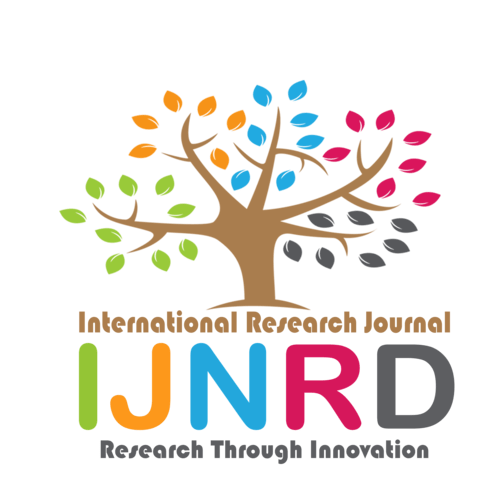|
|||||||||||||||

|
INTERNATIONAL JOURNAL OF NOVEL RESEARCH AND DEVELOPMENT International Peer Reviewed & Refereed Journals, Open Access Journal ISSN Approved Journal No: 2456-4184 | Impact factor: 8.76 | ESTD Year: 2016 Scholarly open access journals, Peer-reviewed, and Refereed Journals, Impact factor 8.76 (Calculate by google scholar and Semantic Scholar | AI-Powered Research Tool) , Multidisciplinary, Monthly, Indexing in all major database & Metadata, Citation Generator, Digital Object Identifier(DOI) |
||||||||||||||
Issue: April 2024
Volume 9 | Issue 4
Review Result and Publication of Paper within : 2-3 days
Click Here For more DetailsFor Authors
Forms / Download
Published Issue Details
Editorial Board
Other IMP Links
Facts & Figure
Impact Factor : 8.76
Issue per Year : 12
Volume Published : 9
Issue Published : 95
Article Submitted :
Article Published :
Total Authors :
Total Reviewer :
Total Countries :
Indexing Partner
Join RMS/Earn 300
Licence
This work is licensed under a Creative Commons Attribution-NonCommercial 4.0 International License







|
Published Paper Details
|
|
| Paper Title: | Indigenous Food Habit System of Padam Tribes with special reference to East Siang District, Arunachal Pradesh |
| Authors Name: | Mr.Tabiram Yirang , Mr.Tabiram Yirang |
| Download E-Certificate: | Download |
| Author Reg. ID: |
IJNRD_188803
|
| Published Paper Id: | IJNRD2303192 |
| Published In: | Volume 8 Issue 3, March-2023 |
| DOI: | |
| Abstract: | Abstract: This paper is an attempt to highlight the indigenous food habit system of the Padam tribes of East Siang District of Arunachal Pradesh. Like any other tribal communities in the world, the Padams, which is one of the sub-tribes of Adi tribes, have a unique socio-cultural life which is always found to be inter-oven with the nature. They have their own traditional methods of preparations and consumption of food items in the society. The places of habitation, topography, climatic conditions, flora and fauna, nature of the land etc greatly influence the food habit patterns of the Padams. They have their own life styles of living, socio-cultural and socio-economic pattern, religions, and faiths and believe etc. Agriculture has been the main source of every food items and drinks in the society. Boiling, roasting, smoking and porridge or pastes are the important traditional methods of preparations and consumption of foods in the society. Whatever may be the kind of foods is not taken in a raw form except some green vegetables, nuts and roots. Rice is the staple food of the Padams living in the region. It is widely cultivated over the hills, valleys and plain areas. Other important food items are Maize, Millet, tapioca, sweet potato, green vegetables, wild roots, nuts, bamboo shoots, herbs and meats of different animals and fishes etc. Rice, maize, millets and tapioca are useful for preparation of local indigenous drinks. The indigenous communities living for thousands of years overlapping with biodiversity have highly complex and very specific knowledge system of management of local resources and their sustainable. Their traditional knowledge of the biological materials is very vast and age old tradition in nature. They have been living in this area overlapping with high diversity of species of flora and fauna in the environment since its antiquity. This high diversity of bio-resources is attributed to their indigenous management system of bio-resources. Their wisdom and indigenous knowledge (IK) has played an important role in the process of its biodiversity conservation in the region. They practice certain traditional system for protecting the diversity of flora and fauna in the region. Key words: Traditional methods, food habits, local resources, biodiversity, bio-resources, indigenous knowledge system(IK)etc. |
| Keywords: | |
| Cite Article: | "Indigenous Food Habit System of Padam Tribes with special reference to East Siang District, Arunachal Pradesh", International Journal of Novel Research and Development (www.ijnrd.org), ISSN:2456-4184, Vol.8, Issue 3, page no.b826-b837, March-2023, Available :http://www.ijnrd.org/papers/IJNRD2303192.pdf |
| Downloads: | 000118758 |
| ISSN: |
2456-4184 | IMPACT FACTOR: 8.76 Calculated By Google Scholar| ESTD YEAR: 2016 An International Scholarly Open Access Journal, Peer-Reviewed, Refereed Journal Impact Factor 8.76 Calculate by Google Scholar and Semantic Scholar | AI-Powered Research Tool, Multidisciplinary, Monthly, Multilanguage Journal Indexing in All Major Database & Metadata, Citation Generator |
| Publication Details: |
Published Paper ID:IJNRD2303192 Registration ID: 188803 Published In: Volume 8 Issue 3, March-2023 DOI (Digital Object Identifier): Page No: b826-b837 Country: Pasighat, East Siang District, Arunachal Pradesh (India), India Research Area: Social Science and Humanities Publisher : IJ Publication Published Paper URL : https://www.ijnrd.org/viewpaperforall?paper=IJNRD2303192 Published Paper PDF: https://www.ijnrd.org/papers/IJNRD2303192 |
| Share Article: | |
|
Click Here to Download This Article |
|
| Article Preview | |
|
|
|
Major Indexing from www.ijnrd.org
| Semantic Scholar | Microsaoft Academic | ORCID | Zenodo |
| Google Scholar | ResearcherID Thomson Reuters | Mendeley : reference manager | Academia.edu |
| arXiv.org : cornell university library | Research Gate | CiteSeerX | PUBLON |
| DRJI | SSRN | Scribd | DocStoc |
ISSN Details
 |
 |
ISSN: 2456-4184
Impact Factor: 8.76 and ISSN APPROVED
Journal Starting Year (ESTD) : 2016
DOI (A digital object identifier)
Conference
Open Access License Policy
Important Details
Social Media
| Copyright © 2024 - All Rights Reserved - IJNRD |












Facebook Twitter Instagram LinkedIn